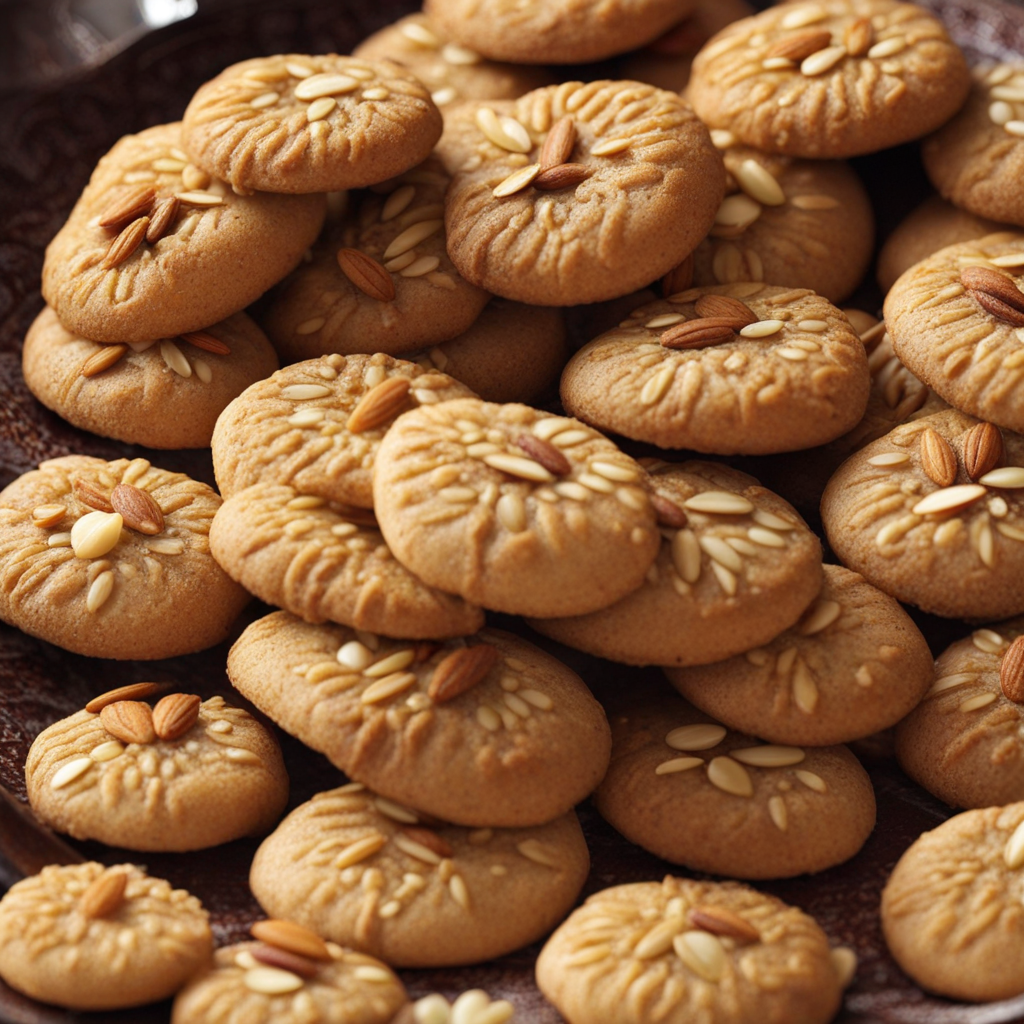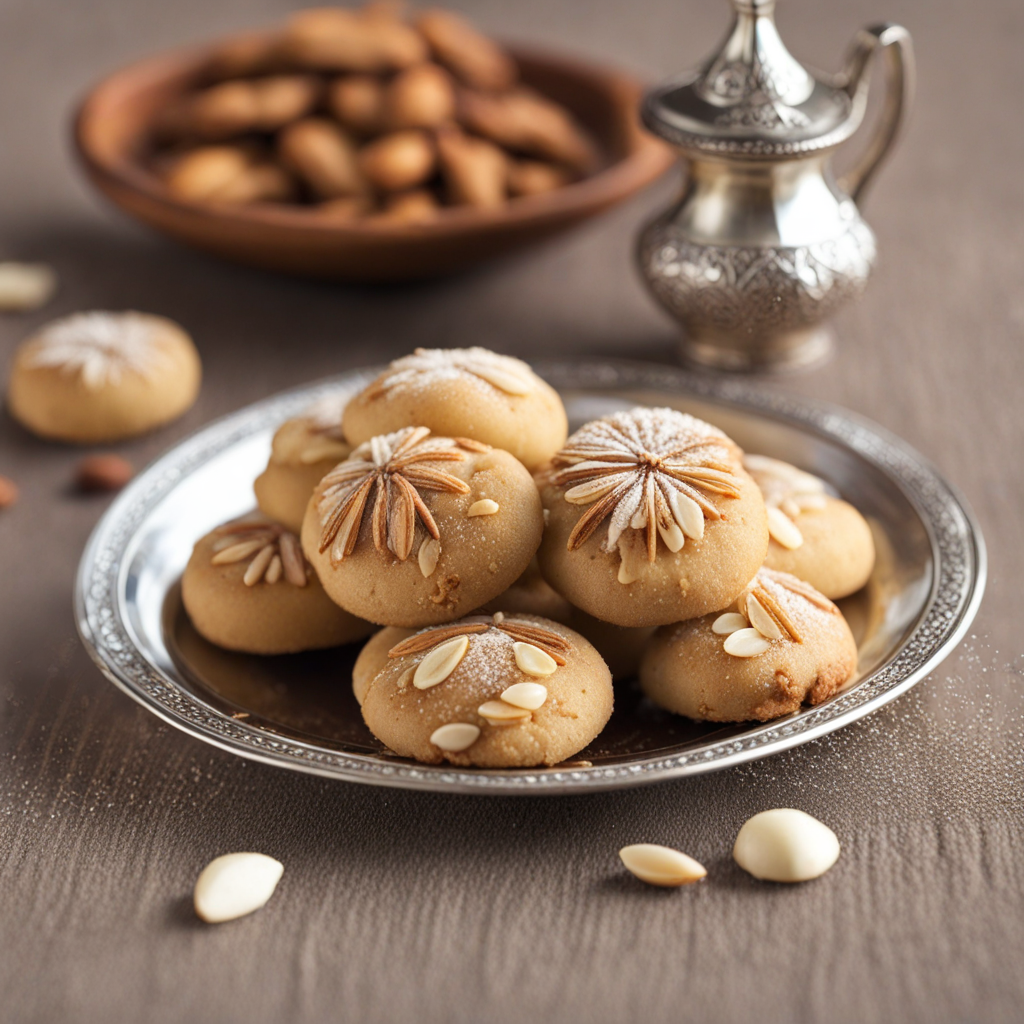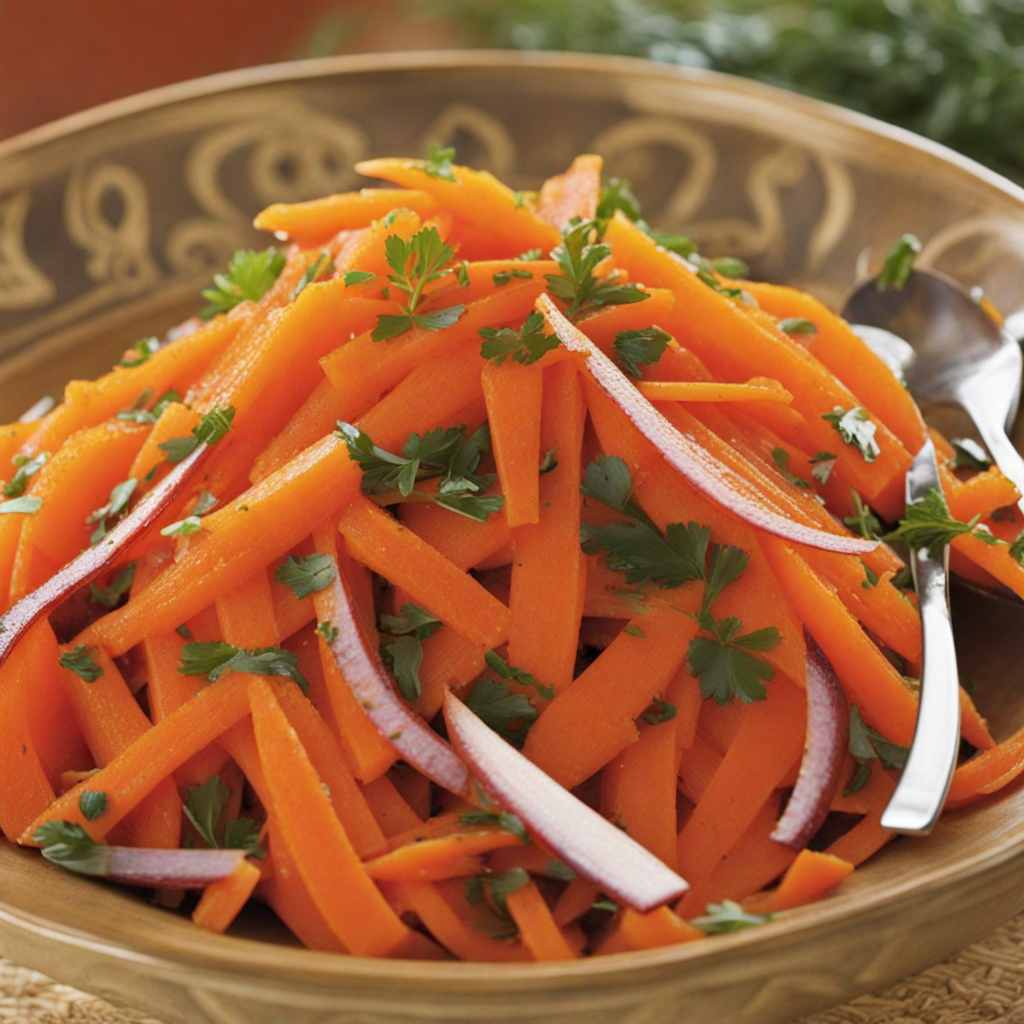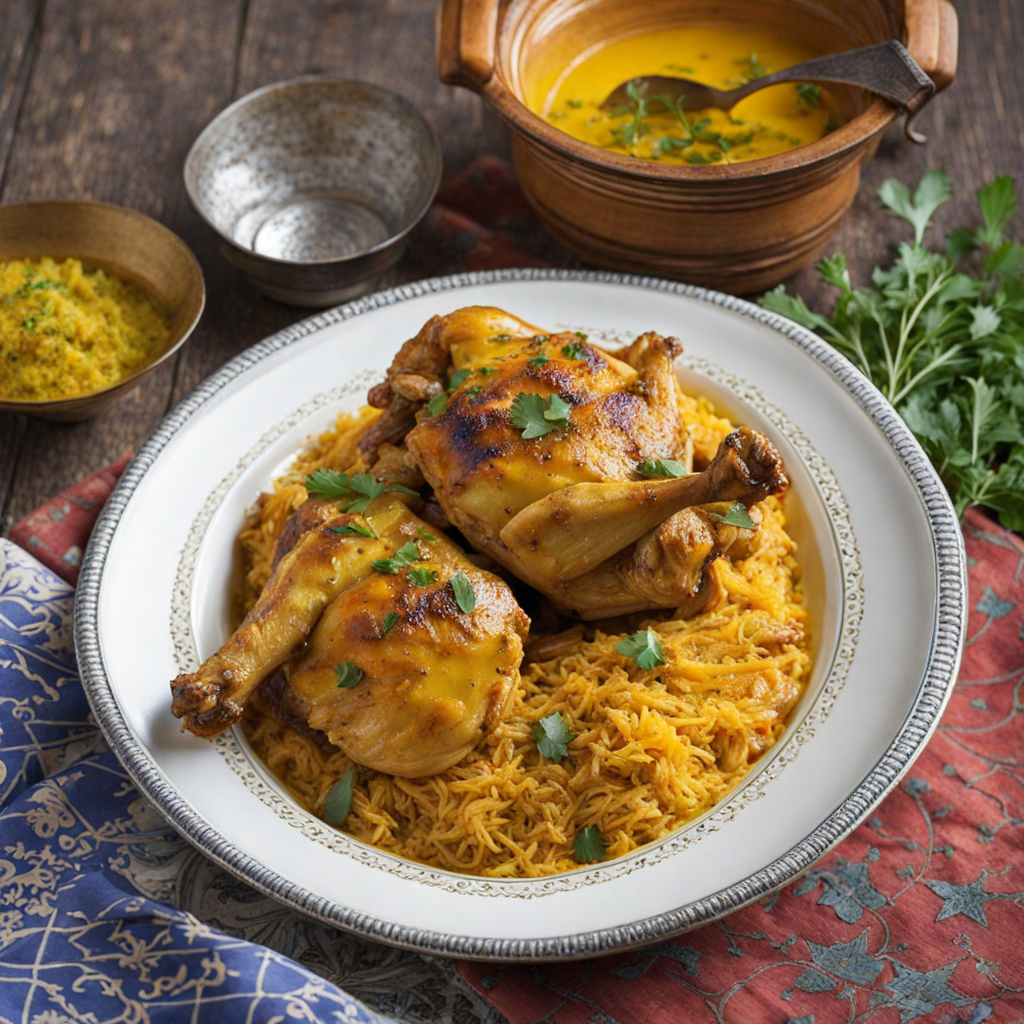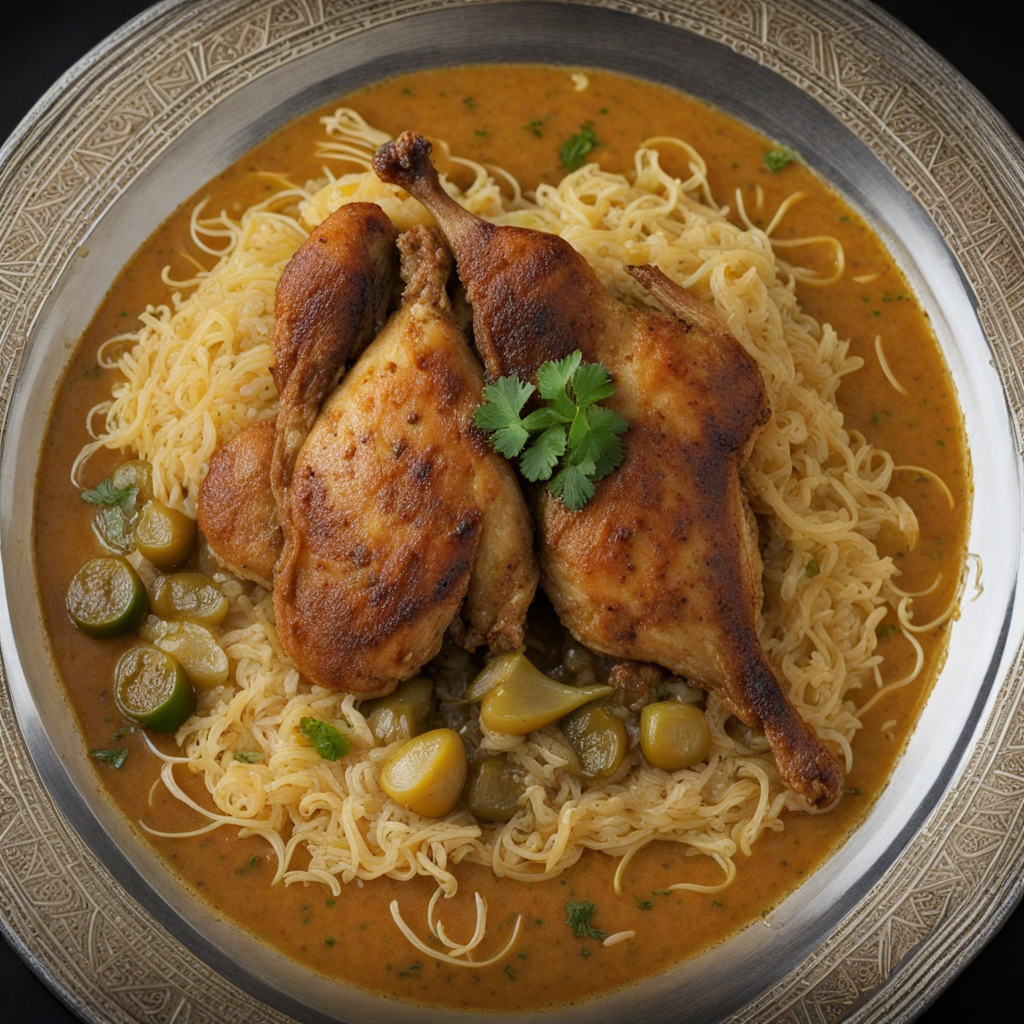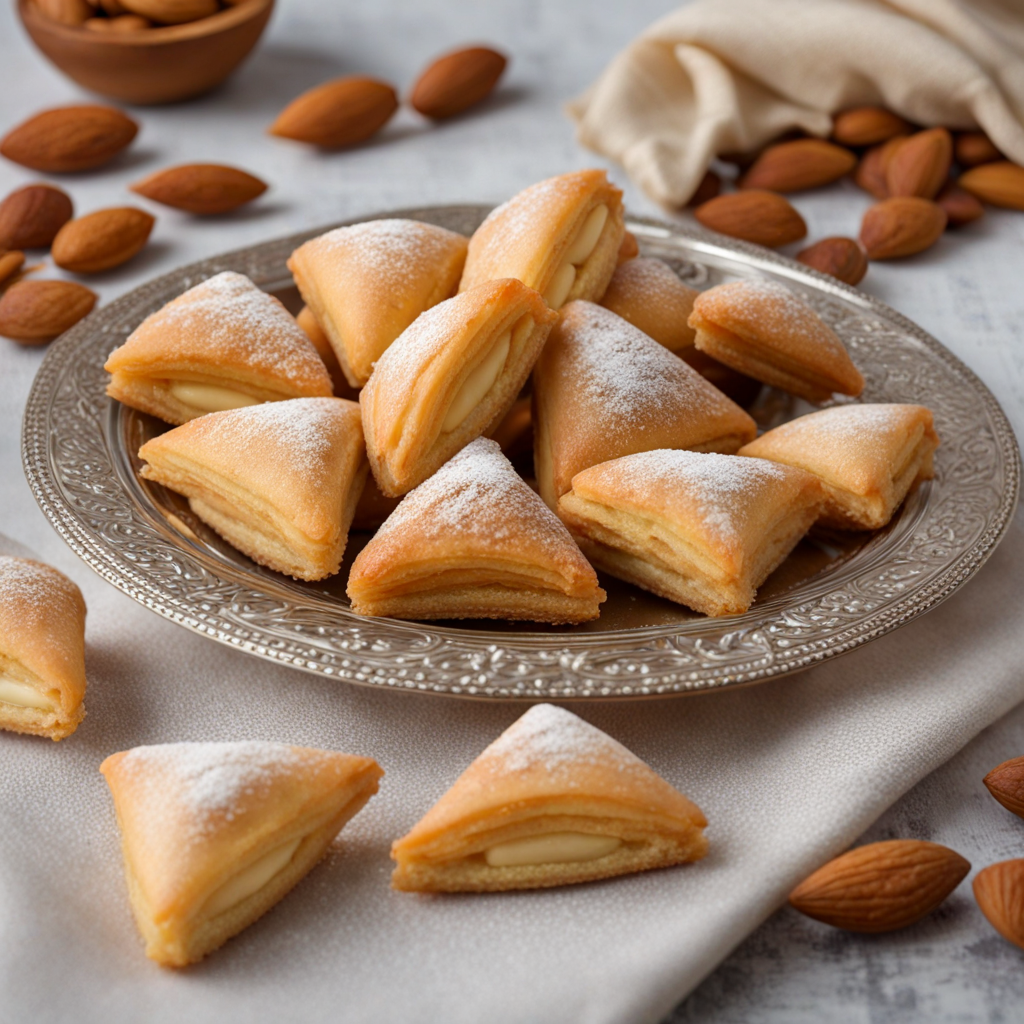Ghriba
Ghriba is a traditional Moroccan cookie that delights the palate with its unique texture and flavor. These delightful treats are primarily made from ground almonds or chickpeas, giving them a distinct nutty taste that pairs beautifully with a hint of sweetness. The dough is typically flavored with aromatic spices like cinnamon and sometimes enhanced with a splash of orange blossom water, which infuses the cookies with a fragrant, floral note. The result is a rich, crumbly cookie that melts in your mouth, offering a delightful balance between rich nuttiness and subtle sweetness. One of the most intriguing aspects of Ghriba is its beautiful cracked surface, which forms during baking. This signature appearance is achieved by rolling the dough into balls and then coating them in powdered sugar before baking. As the cookies rise and cook, they crack open, creating an alluring contrast between the snowy white exterior and the golden interior. Each bite reveals a tender crumb, and the light crunch from the outer layer adds an enjoyable texture that complements the soft center. Ghriba cookies are often enjoyed with a cup of mint tea, making them a staple during Moroccan gatherings and celebrations. They're versatile too; you can find variations that incorporate coconut or sesame seeds, each adding their own unique twist. Whether enjoyed as a snack or a dessert, Ghriba offers a taste of Moroccan hospitality, inviting you to savor the warm, comforting flavors of this enchanting North African cuisine.
How It Became This Dish
The Sweet History of غريبة (Ghriba) in Morocco: A Culinary Journey Ghriba, a delightful Moroccan treat, is more than just a cookie; it embodies the rich tapestry of Moroccan culture and history. With its origins deeply rooted in the ancient traditions of North Africa, ghriba has captivated palates for centuries, evolving through time while maintaining its essential charm. This exploration of ghriba will delve into its origins, cultural significance, and development, revealing why this sweet treat remains a cherished part of Moroccan cuisine. Origins of Ghriba The history of ghriba can be traced back to the diverse influences that have shaped Morocco, from the indigenous Berber tribes to the Arab conquests and later European interactions. The term "ghriba" stems from the Arabic word "غريب" which means "strange" or "unusual." This name reflects the unique texture and flavor profile of the treat, which is distinct from other baked goods. The earliest forms of ghriba likely emerged in the Berber communities, where simple ingredients such as almonds, honey, and sesame seeds were combined. These ingredients were not only readily available but also held nutritional value, making them ideal for sustenance. The practice of creating sweet treats can be traced back to ancient times, with evidence suggesting that the ancient Egyptians and Phoenicians used honey and nuts in their confections. As trade routes flourished, spices and other ingredients from distant lands began to find their way to Moroccan kitchens, enriching the culinary landscape. Cultural Significance Ghriba is not merely a cookie; it is a symbol of hospitality and celebration in Moroccan culture. Traditionally served during religious holidays, family gatherings, and special occasions, ghriba reflects the Moroccan ethos of sharing and community. During Ramadan, for instance, these treats are often enjoyed as part of iftar, the meal that breaks the fast, symbolizing the joy of togetherness and gratitude. The preparation of ghriba is often a communal activity, bringing families and friends together in the kitchen. This collaborative spirit fosters bonds and allows for the transmission of recipes and culinary techniques from one generation to the next. Each family may have its unique spin on ghriba, incorporating local ingredients or adapting the recipe to suit personal tastes. This variation is a testament to Morocco's cultural diversity and the role of food as a medium for storytelling and tradition. Development Over Time Over the centuries, ghriba has undergone a fascinating evolution, adapting to changing tastes and ingredients while remaining true to its roots. Originally, the primary ingredients were simple and straightforward, focusing on nuts and honey. However, as Moroccan cuisine began to blend with influences from Spain, France, and other Mediterranean cultures, ghriba recipes expanded in scope and flavor. One of the most notable developments in ghriba's history is the introduction of a wider variety of nuts, particularly pistachios and walnuts, which have become popular additions to the classic almond base. Additionally, the use of spices such as cinnamon and orange blossom water has enhanced the flavor profile, elevating ghriba from a simple treat to a sophisticated dessert. In the late 19th and early 20th centuries, as Morocco became increasingly exposed to European culinary practices, ghriba began to incorporate elements of French patisserie. This influence is evident in the texture and presentation of the cookies. Modern ghriba often features a delicate crumb and a glossy finish, making it visually appealing as well as delicious. The rise of Moroccan tourism in the late 20th century also contributed to the globalization of ghriba. Travelers from around the world discovered this sweet treat, leading to its inclusion in international culinary repertoires. Today, ghriba can be found in Moroccan bakeries and restaurants around the globe, celebrated for its unique flavors and cultural significance. Ingredients and Varieties The charm of ghriba lies in its simplicity, yet the ingredient list can vary widely, giving rise to numerous regional and personal variations. The most common base for ghriba is almond flour, which provides a rich, nutty flavor. The dough is typically sweetened with sugar and flavored with a hint of vanilla or orange blossom water, imparting a fragrant aroma. In addition to the classic almond ghriba, other popular variations include: 1. Ghriba Bouza: Made with ground sesame seeds, this version showcases the nutty flavor of sesame and is often enjoyed for its unique texture. 2. Ghriba with Coconut: Shredded coconut is incorporated into the dough, adding a tropical twist and chewy texture. 3. Ghriba with Flour: Some recipes include a small amount of flour, resulting in a slightly different texture that is crispier on the outside while remaining soft on the inside. 4. Ghriba Mkaouara: A delightful twist on the traditional recipe, this version often includes a combination of nuts and is shaped into decorative forms, making it a popular choice for celebrations. Modern Interpretations and Global Appeal In recent years, ghriba has seen a resurgence in popularity, both in Morocco and abroad. As food enthusiasts and chefs experiment with traditional recipes, ghriba has become a canvas for creativity. Today, you can find gourmet versions of ghriba infused with exotic flavors like matcha, rosewater, or even chocolate, appealing to contemporary palates while respecting the essence of the original treat. Moreover, the rise of the health-conscious consumer has prompted a shift towards using alternative ingredients, such as gluten-free flours or natural sweeteners, allowing ghriba to cater to a broader audience. This adaptability highlights ghriba's resilience and relevance in a rapidly changing culinary landscape. Conclusion The history of ghriba is a testament to Morocco's rich culinary heritage and the enduring power of food to unite people across generations. From its ancient origins to its modern interpretations, ghriba encapsulates the essence of Moroccan culture—a blend of tradition, hospitality, and creativity. As this beloved treat continues to evolve, it remains a symbol of celebration and community, inviting all to partake in the sweetness of Moroccan life. Whether enjoyed with tea in a bustling café or shared among family during a holiday feast, ghriba stands as a delicious reminder of Morocco's vibrant history and the stories that are woven into every bite.
You may like
Discover local flavors from Morocco


